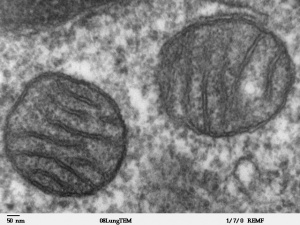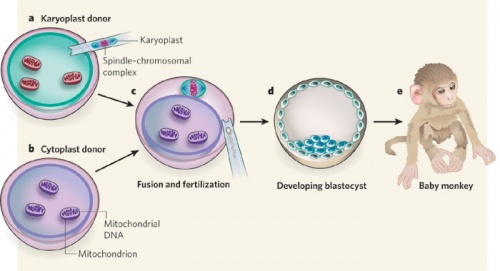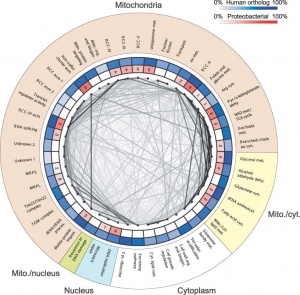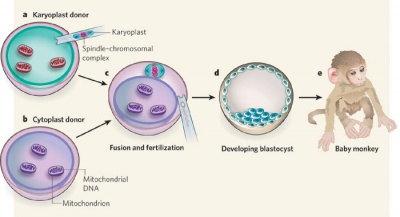Mitochondria
| Embryology - 4 May 2024 |
|---|
| Google Translate - select your language from the list shown below (this will open a new external page) |
|
العربية | català | 中文 | 中國傳統的 | français | Deutsche | עִברִית | हिंदी | bahasa Indonesia | italiano | 日本語 | 한국어 | မြန်မာ | Pilipino | Polskie | português | ਪੰਜਾਬੀ ਦੇ | Română | русский | Español | Swahili | Svensk | ไทย | Türkçe | اردو | ייִדיש | Tiếng Việt These external translations are automated and may not be accurate. (More? About Translations) |
Introduction
Originally discovered in muscle by Kölliker in 1857, mitochondria are the "powerhouses" of the cell and the location where respiration occurs at the cellular level. These cytoplasmic organelles also contain their own DNA (mitochondrial DNA or mtDNA) that has been originally inherited only from the oocyte (maternal inheritance). The spermatozoa (paternal) mitochondria, required for energy for fertilization motility, can enter the oocyte but are generally destroyed during the first mitotic cell divisions. This pattern of inheritance has important implications for a variety of mitochondrial associated diseases, usually occurring in tissues requiring lots of energy (muscle, brain). Recent experiments have employed swapping maternal mitochondrial DNA in mammalian oocytes.
Swapping mitochondrial DNA mammalian oocytes[1]
Some Recent Findings

|
| More recent papers |
|---|
|
This table allows an automated computer search of the external PubMed database using the listed "Search term" text link.
More? References | Discussion Page | Journal Searches | 2019 References | 2020 References Search term: Mitochondria Embryology <pubmed limit=5>Mitochondria Embryology</pubmed> |
Maternal Inheritance
Most animals
- Oocyte mitochondria (maternal) are the only mitochondria inherited. (see genetics below)
- maternal mitochondrial genome inheritance.
- Spermatozoa mitochondria (paternal) can enter oocyte at fertilisation.
- Male spermatozoa are destroyed early in embryonic development (mechanism not yet elucidated)
- worm - (C. elegans) suggest ubiquitination occurs followed by autophagy.[5]
- mouse - suggest a more passive process, prefertilization sperm mtDNA elimination and uneven mitochondrial distribution in embryos.[2]
Paternal Mitochondria
| Spermatozoa organelles, including mitochondria, are destroyed in some species by the process of autophagy following fertilisation.[6]
Recent studies in mice suggest that additional mechanisms may be used in paternal mitochondrial elimination.[2] |
|
- Links: Spermatozoa Development
History Mitochodria
1857 Kölliker discovers mitochondria in muscle
1929 Karl Lohmann discovered ATP
1940s and 1950s ATP is formed in cell respiration in mitochondria and photosynthesis in chloroplasts of plants
1960 Efraim Racker and co-workers isolated, from mitochondria, the enzyme "F o F 1 ATPase" now call ATP synthase
1963 There’s DNA in those organelles DNA is directly visualized in first chloroplasts and then mitochondria, from the JCB Archive.
1992 Wallace identified degenerative disease caused by mtDNA mutations
1997 Nobel Prize in Chemistry - The three laureates have performed pioneering work on enzymes that participate in the conversion of the "high-energy" compound adenosine triphosphate (ATP).
- Paul D. Boyer and John E. Walker "for their elucidation of the enzymatic mechanism underlying the synthesis of adenosine triphosphate (ATP)"
- Jens C. Skou "for the first discovery of an ion-transporting enzyme, Na+, K+ -ATPase
Evolution Mitochondria
- primitive Eubacterium
- symbiotic relationship with eukaryotic cell
- circular DNA
- see antibiotic-induced deafness due to similarity of mitochondrial and bacterial ribosomes
- genes transferred to nucleus
- mitochondrial genome bp
- 366,924 Arabidopsis
- 16,569 Human
- 5966 Plasmodium
Mitochondrial Genome
- In humans this genome is maternally inherited.
- Exists as multiple copies within the matrix of each mitochondrion within the cytoplasm of cells.
- In 1981 the human mitochondrial genome was sequenced.
- The genome is a small circular DNA molecule 16,568 bp in length containing 37 genes.
- 24 genes specify RNA molecules involved in protein synthesis (22 transfer RNAs (tRNA) and 2 ribosomal RNAs (rRNA))
- 13 genes encode proteins required for the biochemical reactions that make up respiration.
Spindle Transfer
(ST) An Assisted Reproductive Technology term referring to the transfer of the metaphase II-arrested (MII) spindle-chromosomal complex isolated as a karyoplast from a donor oocyte to the cytoplasm of a second recipient oocyte. The term cytoplast refers to the enucleated recipient oocyte. This technique has been suggested as a clinical solution to mitochondrial inherited disorders.
Swapping mitochondrial DNA mammalian oocytes[1]
- Links: Assisted Reproductive Technology | Mitochondrial DNA Deletion Syndromes | PMID 20539289
Mitochondria Components
Outer Membrane
- porin - membrane channel, allows ions and metabolites into the mitochondria (<5000 daltons)
Intermembrane Space
- similar to the cytosol with respect to the small molecules it contains
- also enzymes that use ATP
Inner Membrane
- cardiolipin - phospholipid, makes membrane impermeable to ions (unique to mitochondria inner membrane)
- transport proteins - permeable to molecules required in the matrix
Cristae
- increase inner membrane surface area
- tubular, vesicular or flat cristae
- Adenosine triphosphate (ATP) synthase
- respiratory electron transfer chain proteins
- transport proteins
Matrix
- metabolic enzymes of citric acid cycle (=Krebs) (100s of enzymes) (MH- do not need to know biochemical details of this cycle)
- genetic material DNA, tRNA, ribosomes
Mitochondria DNA
- double stranded circular DNA (mitoDNA. mtDNA)
- 1981 complete human sequence (16,569 nucleotides)
- 37 genes
- encodes 13 polypeptides involved in oxidative phosphorylation
- remaining genes transfer RNA (tRNA) and ribosomal RNA (rRNA)
- multiple copies within the matrix
- maternally inherited
- remainder encoded by nuclear DNA
- proteins made in cytosol and imported into mitochondria
Mitochondria Protein Synthesis
Many mitochondrial proteins are encoded by nuclear DNA
- synthesis begins in the cell cytoplasm
- imported into the mitochondria
- targeting similar to signal sequence for RER
- once in matrix signal sequence is cleaved (by Hsp70)
- protein then folds (by Hsp60)
- proteins for mitochondrial membrane or intermembranous space
- additional signal following matrix localization
Mitochondrial targeting signal (MTS) - alternating amino acid pattern (amphipathic helix) with a few hydrophobic amino acids and a few plus-charged amino acids at the N terminus.
Links: Replication and preferential inheritance of hypersuppressive petite mitochondrial DNA | Home Reference - Mitochondrial DNA
Mitochondrial Disorders
There has been recent discussion on the use of specialised Assisted Reproductive Technology (ART) techniques to allow replacement of maternal mitochondria with genetic abnormalities with a healthy donor mitochondria.
| Mitochondrial DNA disorder | Description | Prevalence | Life expectancy/morbidity |
|---|---|---|---|
| Kearns–Sayre syndrome | Progressive blindness and blocked heart | Rare disease | Onset before 15 |
| Chronic progressive external opthalmoplegia (CPEO) | Progressive wastage of eyelids, eyes and sometimes facial muscles | Rare disease | Onset in young adulthood |
| Pearson syndrome | Anaemia, pancreatic failure, muscle wastage | Very rare (less than 100 worldwide) | Early death |
| Myopathy, encephalopathy, lactic acidosis and stroke (MELAS) | Stroke like episodes; muscle spasm; early dementia | Rare disease | Death before 40 |
| Myoclonic epilepsy and ragged-red fibres (MERFF) | Epilepsy, hearing loss, lactic acidosis, short stature | 1 in 400,000 across Europe | Childhood onset |
| Neurogenic weakness, ataxia and retinitis pigmentosa (NARP) | Muscle weakness, vision loss, learning disabilities | Rare disease | Onset in early childhood. Early death |
| Maternally inherited Leigh syndrome (MILS) | Muscle weakness, heart and kidney failure, delayed development | Very rare | Onset in infancy. Death in early childhood |
| Maternally inherited diabetes and deafness (MIDD) | Combination of all types of diabetes with deafness | Rare disease | Adult onset |
| Leber hereditary optic neuropathy (LHON) | Rapid blindness | 1 in 30,000 across Europe | Range from early childhood to 70s |
| Myopathy and diabetes | Covers forms of muscular dystrophy | From infancy. Early death | |
| Sensorineural hearing loss | Covers a range of hearing loss through to deafness | Common condition but rarely caused by mitochondrial disease | Onset at any age |
| Exercise intolerance | Range from lethargy to muscle wastage | 1 in 8,000 but symptoms often combine with others | Onset in early life |
| Fatal infantile encephalopathy (Leigh syndrome) |
Brain and nervous system dysfunctions | Very rare | Onset in infancy. Death in early childhood |
|
Table based on Annex D, UK Mitochondrial Donation 2014. | ||
References
- ↑ 1.0 1.1 <pubmed>19759608</pubmed>
- ↑ 2.0 2.1 2.2 2.3 <pubmed>23878233</pubmed>| Proc Natl Acad Sci U S A. Cite error: Invalid
<ref>tag; name 'PMID23878233' defined multiple times with different content Cite error: Invalid<ref>tag; name 'PMID23878233' defined multiple times with different content Cite error: Invalid<ref>tag; name 'PMID23878233' defined multiple times with different content - ↑ <pubmed>24244193</pubmed>
- ↑ <pubmed>23063123</pubmed>
- ↑ <pubmed>24528894</pubmed>
- ↑ <pubmed>22033522</pubmed>
Search PubMed
Search Pubmed: Mitochondria
Terms
- maternal spindle transfer - (MST) An Assisted Reproductive Technology term. The “maternal spindle” is the group of maternal chromosomes within the oocyte, which are shaped in a spindle. The transfer technique involves removing the spindle from the mother’s oocyte before it is fertilised by the father’s spermatozoa. The spindle is then placed into a donor oocyte with healthy mitochondria, from which the donor’s spindle, and therefore her nuclear material, has been removed.
- Pro-nuclear transfer - (PNT) An Assisted Reproductive Technology term. The pro-nucleus is the nucleus of either a spermatozoa or an oocyte during the process of fertilisation after the sperm enters the egg, but before they fuse. Transfer involves removing the pro-nuclei from a newly fertilized oocyte that has unhealthy mitochondria. The pro-nuclei are then transferred into a donated embryo, with healthy mitochondria, that has had its own, original pro-nuclei removed.
External Links
External Links Notice - The dynamic nature of the internet may mean that some of these listed links may no longer function. If the link no longer works search the web with the link text or name. Links to any external commercial sites are provided for information purposes only and should never be considered an endorsement. UNSW Embryology is provided as an educational resource with no clinical information or commercial affiliation.
- UNSW Cell Biology Lecture Mitochondria
Glossary Links
- Glossary: A | B | C | D | E | F | G | H | I | J | K | L | M | N | O | P | Q | R | S | T | U | V | W | X | Y | Z | Numbers | Symbols | Term Link
Cite this page: Hill, M.A. (2024, May 4) Embryology Mitochondria. Retrieved from https://embryology.med.unsw.edu.au/embryology/index.php/Mitochondria
- © Dr Mark Hill 2024, UNSW Embryology ISBN: 978 0 7334 2609 4 - UNSW CRICOS Provider Code No. 00098G




